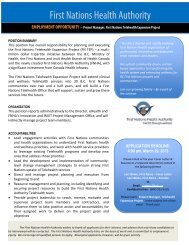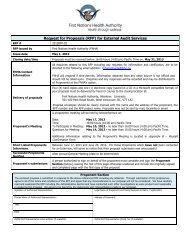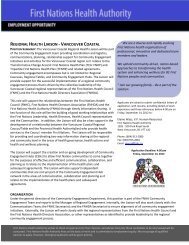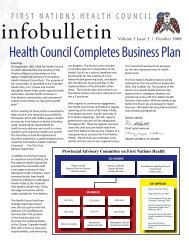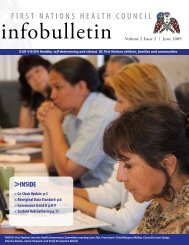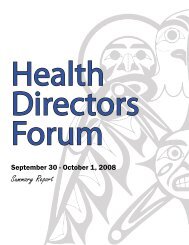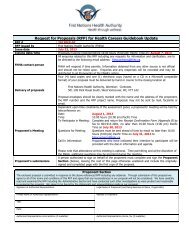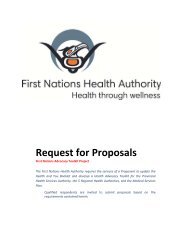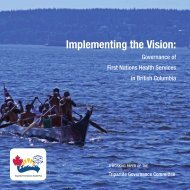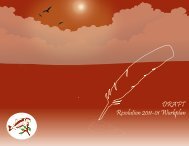unifying and strengthening the response to hiv and aids in ...
unifying and strengthening the response to hiv and aids in ...
unifying and strengthening the response to hiv and aids in ...
- No tags were found...
You also want an ePaper? Increase the reach of your titles
YUMPU automatically turns print PDFs into web optimized ePapers that Google loves.
The Foundation <strong>and</strong> Future of Work <strong>to</strong>Address Hiv/Aids among Aborig<strong>in</strong>al PeopleParticipants discussed a wide range of issues related <strong>to</strong> build<strong>in</strong>g on <strong>the</strong> strengths of <strong>the</strong> funders,agencies <strong>and</strong> <strong>in</strong>dividuals work<strong>in</strong>g <strong>to</strong> halt <strong>the</strong> spread of HIV/AIDS among Aborig<strong>in</strong>al people <strong>and</strong>communities <strong>in</strong> B.C. This <strong>in</strong>cluded discussion of <strong>the</strong> strengths upon which future <strong>in</strong>itiativescan build, some key actions for stakeholders, <strong>and</strong> an <strong>in</strong>-depth discussion of <strong>the</strong> Renew<strong>in</strong>g ourResponse Leaders’ Group Prov<strong>in</strong>cial Coord<strong>in</strong>ation Strategy proposal. A summary of <strong>the</strong>sediscussions is provided here.Successes <strong>and</strong> strengths <strong>in</strong> address<strong>in</strong>g HIV/AIDS among aborig<strong>in</strong>al people <strong>in</strong> B.C.Participants identified that <strong>the</strong>re are three ma<strong>in</strong> strengths <strong>and</strong> successes that will help <strong>to</strong> move<strong>the</strong> work of address<strong>in</strong>g Aborig<strong>in</strong>al HIV/AIDS forward <strong>in</strong> B.C.:1. The existence <strong>and</strong> operation of three prov<strong>in</strong>ce-wide Aborig<strong>in</strong>al HIV/AIDS organizations: CheeMamuk, Heal<strong>in</strong>g our Spirit, <strong>and</strong> Red Road. These three engage <strong>in</strong> prevention, education,resources, shar<strong>in</strong>g health data, work<strong>in</strong>g with Aborig<strong>in</strong>al communities, tra<strong>in</strong><strong>in</strong>g serviceproviders. There is also a strong base of Aborig<strong>in</strong>al HIV/AIDS Service Organizations who work<strong>in</strong> different communities;2. A high level of awareness <strong>and</strong> commitment <strong>to</strong> move forward, from a range of stakeholders<strong>in</strong> <strong>the</strong> field. This groups engages <strong>in</strong> dialogue between partners that <strong>in</strong>cludes a wide rangeof complex <strong>to</strong>pics <strong>in</strong> an attempt <strong>to</strong> come up with <strong>the</strong> best <strong>response</strong> <strong>to</strong> HIV/AIDS amongAborig<strong>in</strong>al populations. This group of stakeholders is concerned that <strong>the</strong> results of <strong>the</strong>sediscussions should benefit all Aborig<strong>in</strong>al people <strong>in</strong> B.C.;3. The development of <strong>the</strong> Tripartite First Nations Health Plan, which has <strong>the</strong> potential forchang<strong>in</strong>g <strong>the</strong> way that stakeholders will work <strong>to</strong>ge<strong>the</strong>r.Actions that can happen immediately:1. Funder <strong>and</strong> service organization collaboration, work<strong>in</strong>g <strong>in</strong> partnership <strong>and</strong> cementedby process-related fund<strong>in</strong>g <strong>and</strong> <strong>in</strong>-k<strong>in</strong>d assistance. Service organizations can work <strong>in</strong>collaboration with funders <strong>to</strong> prioritize programs <strong>to</strong> be funded, <strong>and</strong> funders can build <strong>the</strong>capacity of service organizations <strong>in</strong> areas such as evaluation <strong>and</strong> program improvement;2. Build<strong>in</strong>g relationships with a wider range of partners <strong>in</strong>clud<strong>in</strong>g non-health organizations <strong>and</strong>M<strong>in</strong>istries;3. Collaboration between AASO’s <strong>and</strong> ma<strong>in</strong>stream Service Organizations. This could <strong>in</strong>cludecommitments or written pro<strong>to</strong>col agreements between ASO’s <strong>and</strong> SO’s, <strong>in</strong>clud<strong>in</strong>g a disputeresolution mechanism;4. Involv<strong>in</strong>g <strong>the</strong> two prov<strong>in</strong>ce-wide AASO’s, Chee Mamuk, B.C. Centre for Disease Control, <strong>and</strong>regional <strong>and</strong> local groups <strong>in</strong> plann<strong>in</strong>g, <strong>and</strong> identify<strong>in</strong>g ways of pool<strong>in</strong>g our resources <strong>and</strong>knowledge;5. Involv<strong>in</strong>g APHA’s, youth, <strong>and</strong> elders <strong>in</strong> <strong>the</strong> work of plann<strong>in</strong>g <strong>and</strong> build<strong>in</strong>g relationships;6. Reduc<strong>in</strong>g duplication of services by recogniz<strong>in</strong>g overlap <strong>in</strong> clients;7. Exp<strong>and</strong><strong>in</strong>g communication networks by us<strong>in</strong>g exist<strong>in</strong>g groups such as <strong>the</strong> Pacific AIDSNetwork;8. Develop<strong>in</strong>g partnerships between government <strong>and</strong> First Nations that result <strong>in</strong> more FirstNations control.Unify<strong>in</strong>g <strong>the</strong> Response <strong>to</strong> HIV <strong>and</strong> AIDS <strong>in</strong> Aborig<strong>in</strong>al Communities <strong>in</strong> BC F<strong>in</strong>al Report 11



